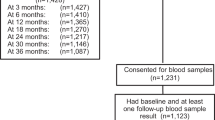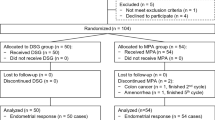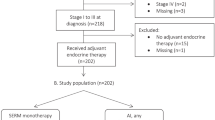Abstract
A randomized, double-blind, placebo-controlled multicenter trial involving 107 men receiving bicalutamide (‘Casodex’) 150 mg/day therapy following radical therapy for prostate cancer assessed tamoxifen (‘Nolvadex’) 20 mg/day and anastrozole (‘Arimidex’) 1 mg/day for the prophylaxis and treatment of gynecomastia/breast pain. Tamoxifen, but not anastrozole, significantly reduced the incidence of gynecomastia/breast pain when used prophylactically and therapeutically. Serum testosterone levels increased with tamoxifen relative to placebo but prostate-specific antigen levels declined in all treatment groups. Further studies are needed to define the optimum tamoxifen dose and to assess any impact on cancer control. The use of tamoxifen in this setting remains to be investigated.
This is a preview of subscription content, access via your institution
Access options
Subscribe to this journal
Receive 4 print issues and online access
$259.00 per year
only $64.75 per issue
Buy this article
- Purchase on Springer Link
- Instant access to full article PDF
Prices may be subject to local taxes which are calculated during checkout




Similar content being viewed by others
References
Wirth MP et al. Bicalutamide 150 mg in addition to standard care in patients with localized or locally advanced prostate cancer: results from the second analysis of the early prostate cancer program at median followup of 5.4 years. J Urol 2004; 172: 1865–1870.
Iversen P et al. Bicalutamide monotherapy compared with castration in patients with nonmetastatic locally advanced prostate cancer: 6.3 years of followup. J Urol 2000; 164: 1579–1582.
McLeod DG, Iversen P . Gynecomastia in patients with prostate cancer: a review of treatment options. Urology 2000; 56: 713–720.
Verhelst J et al. Endocrine profiles during administration of the new non-steroidal anti-androgen Casodex in prostate cancer. Clin Endocrinol (Oxf) 1994; 41: 525–530.
Tyrrell CJ et al. Prophylactic breast irradiation with a single dose of electron beam radiotherapy (10 Gy) significantly reduces the incidence of bicalutamide-induced gynecomastia. Int J Radiat Oncol Phys Biol 2004; 60: 476–483.
Widmark A et al. Does prophylactic breast irradiation prevent antiandrogen-induced gynecomastia? Evaluation of 253 patients in the randomized Scandinavian trial SPCG-7/SFUO-3. Urology 2003; 61: 145–151.
Braunstein GD . Aromatase and gynecomastia. Endocr Relat Cancer 1999; 6: 315–324.
Parker LN, Gray DR, Lai MK, Levin ER . Treatment of gynecomastia with tamoxifen: a double-blind crossover study. Metabolism 1986; 35: 705–708.
Alagaratnam TT . Idiopathic gynecomastia treated with tamoxifen: a preliminary report. Clin Ther 1987; 9: 483–487.
McDermott MT, Hofeldt FD, Kidd GS . Tamoxifen therapy for painful idiopathic gynecomastia. South Med J 1990; 83: 1283–1285.
Staiman VR, Lowe FC . Tamoxifen for flutamide/finasteride-induced gynecomastia. Urology 1997; 50: 929–933.
Serels S, Melman A . Tamoxifen as treatment for gynecomastia and mastodynia resulting from hormonal deprivation. J Urol 1998; 59: 1309.
Goss PE, Tye LM . Anastrozole: a new selective nonsteroidal aromatase inhibitor. Oncology (Huntingt) 1997; 11: 1697–1703.
Krause W, Holland-Moritz H, Schramm P . Treatment of idiopathic oligozoospermia with tamoxifen—a randomized controlled study. Int J Androl 1992; 15: 14–18.
Soloway MS et al. Bicalutamide in the treatment of advanced prostatic carcinoma: a phase II noncomparative multicenter trial evaluating safety, efficacy and long-term endocrine effects of monotherapy. J Urol 1995; 154: 2110–2114.
Ahn HS, Park CM, Lee SW . The clinical relevance of sex hormone levels and sexual activity in the ageing male. BJU Int 2002; 89: 526–530.
Tyrrell CJ et al. Casodex™ 10-200 mg daily, used as monotherapy for the treatment of patients with advanced prostate cancer. An overview of the efficacy, tolerability and pharmacokinetics from three Phase II dose-ranging studies. Eur Urol 1998; 33: 39–53.
Acknowledgements
We gratefully acknowledge the contribution to the trial of the following investigators: A Cantwell (Atlantic Urological Associates, Daytona Beach, FL, USA); J Ross (Mississippi Center for Clinical Research, Jackson, MI, USA); RJ Ross (Hattiesburg Clinic, Hattiesburg, MS, USA); K Tomera (Alaska Clinical Research Center, Anchorage, Alaska); N Nemoy (Cedars-Sinai Medical Center, Los Angeles, CA, USA); D Keiller (4033 3rd Avenue, San Diego, CA); and PM Knapp (Urology of Indiana; Indianapolis, IN, USA).
Author information
Authors and Affiliations
Corresponding author
Additional information
‘Arimidex’, ‘Casodex’, and ‘Nolvadex’ are trademarks of the AstraZeneca group of companies.
Rights and permissions
About this article
Cite this article
Saltzstein, D., Sieber, P., Morris, T. et al. Prevention and management of bicalutamide-induced gynecomastia and breast pain: randomized endocrinologic and clinical studies with tamoxifen and anastrozole. Prostate Cancer Prostatic Dis 8, 75–83 (2005). https://doi.org/10.1038/sj.pcan.4500782
Received:
Revised:
Accepted:
Published:
Issue Date:
DOI: https://doi.org/10.1038/sj.pcan.4500782
Keywords
This article is cited by
-
Therapeutic drug monitoring of oral targeted antineoplastic drugs
European Journal of Clinical Pharmacology (2021)
-
Treatment strategies to prevent and reduce gynecomastia and/or breast pain caused by antiandrogen therapy for prostate cancer
Strahlentherapie und Onkologie (2020)
-
Diagnosis and Management of Gynecomastia for Urologists
Current Urology Reports (2018)
-
Profylactische tepelbestraling bij bicalutamidegebruik vanwege prostaatkanker: klinische noodzaak?
Tijdschrift voor Urologie (2014)
-
Tamoxifen for the management of breast events induced by non-steroidal antiandrogens in patients with prostate cancer: a systematic review
BMC Medicine (2012)



